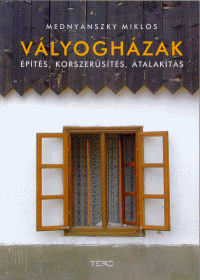
The oldest building material of mankind is the earth itself. It has been used for several thousands of years for the construction of houses, palaces, community buildings as well as for various strategic goals. Earthworks can be found in all civilizations from the Great Wall of China to the Native American pyramids in North America.
The construction of the still standing Hungarian clay houses lasted roughly from the 80s of the 19th century to the mid-1970s.
Their forms spread from the conventional, peasant, "long" house on the border to houses with urban layout, or detached houses with a square or broken floor plan, copying bourgeois villas. Farm buildings, houses or buildings for community goals were also built from clay. It is a very important task to keep these houses in good condition, to preserve them or to renovate them according to the demands of today. For hundreds of thousands of families, the only option is to live in adobe houses.
This task is also important because in our home country in the 21st century - even if only slowly - the healthy, natural way of life is coming to the fore, so it is becoming important for more and more people to live in houses built using this method. Since the new construction of such buildings (known as bio-houses or eco-houses) requires a considerable financial sacrifice, many are turning to the existing buildings.
With my book, I would like to help the people who live in such houses, or those who intend to buy such houses, with the aim of renovating or perhaps converting them and using them for the country - and of course for themselves at the same time - to preserve.
The book is divided into three main parts:
I. The construction of earthen houses and their construction
II. The typical faults in earth building houses and their repair
III. The possibilities of modernizing earth building houses
In the first chapter the construction methods for the structures of earthen houses are discussed briefly. I also show other structures for these houses, which are also very important and require extra attention in the case of adobe houses (foundations, ceilings, insulation, roofs, etc.)
In the second chapter the errors are shown that cause problems in earthen houses. These are for example the walls, the mistakes in cleaning or the most important and worrying problem: the humidity.
In the third chapter I give advice to those who are considering buying or renovating mud houses. When you buy a house, you have to pay attention to and get to know a lot - but with mud houses there are even more factors that, if ignored, can cause a lot of worries in the future. There are also such factors that one does not have to consider when buying conventional houses, but these are not to be ignored in earth houses.
At the end of the book, I would like to share a considerable technical collection for those interested so that I can help them with their inquiries.
When compiling the handwriting of the book, I did pay attention to not focus on any specific - i.e. branded - building materials or technology, in order to avoid even the appearance that I represent the interests of any manufacturer.
TABLE OF CONTENTS
INTRODUCTION
I. CHAPTER
The construction of earthen houses - the superstructures of the houses - the selection of the location of the houses - the construction of the foundation walls - the hallway - the types of earth walls and their construction methods - the ceilings in the earthen construction houses - the beams - the materials of the bridges and their production - doors and windows in earthen construction houses - surface designs (plastering, cladding) - the roof and its additions
II. CHAPTER
The mistakes of the mud houses and repair of the damage to the foundation walls - the damage to the walls of the earthen construction houses - the faults in the ceilings and bridges - the damage to the roofs - the faults in the doors and windows - the plastering of the earthen construction houses - biological damage in the earthen construction houses - the earthen construction house and the damp
III. CHAPTER
The possibilities for modernizing adobe houses - theoretical viewpoints of modernization and renovation - the importance of 0.5 liters of red wine and pipes when renovating an adobe house - the possibilities of functional renovation and its appropriate solutions for adobe- and farmhouses - demolition and relocation of walls, ceilings and weight-bearing structures - renovation of cladding - replacement of doors and windows - modernization of heating - renewal of installation technology
IV. CHAPTER
Specialized literature
The book can be bought in bookstores in Hungary and in stores of TERC Ltd. in Budapest 14th district, Pillangó-park.
|